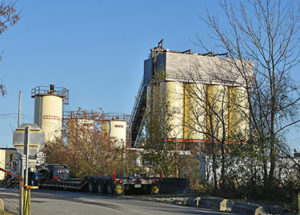Statement from PJ Keating Company President
Your recent article entitled “Complaints about PJ Keating Increase,” released November 10, 2021, contains numerous inaccurate statements that we could have corrected if we had been given the chance to comment prior to publication. Unfortunately, the article left a false impression with readers about our company, which has been operating in Acushnet for more than 100 years. A more balanced account would have avoided the following errors:
• Your statement that ‘[o]ne of the changes (to the aforementioned bylaws) allows liquid asphalt to be stored in large tanks that can now be seen from the road’ is inaccurate. These tanks cannot be seen from the road. The picture that you took is of something different, asphalt storage silos. Moreover, there was no change to any bylaw that “allowed the company to move the asphalt plant operation to the front of the property”. The property is zoned industrial and the current uses of the property, including location of the asphalt plant and its components, are allowed by right.
• Your article states that “Several residents complained that their cars were damaged from tar”. PJK has investigated this — as the company does all complaints received from residents — and found that the ‘tar balls’ are naturally occurring artillery fungus (Sphaerobolus stellatus) and has nothing to do with PJK operations.
• Your articles says that “Mr. Smith asked about air quality monitors. He said the people who work at PJK or visit there are in their vehicles, but the residents are exposed to bad air.” PJK employees do not work in their vehicles; they are in the open air as well, in very close proximity to the asphalt plant, and have experienced no “bad air” or overwhelming odors. Furthermore, PJK has installed a system of air quality monitors at the perimeter of its property to track dust and particulates leaving its site.
• Your article quotes Mr. Smith as saying “wheels on the trucks clearly have not been washed.” With the exception of the trucks entering and exiting the site solely for asphalt (which are driving only on paved surfaces within the site), it is mandatory that all trucks go through the tire wash system.
• The article quotes Cheryl Hall as asserting that PJK reported there was no silica in the air particles. PJK never claimed that there is no silica, which is a naturally occurring substance and literally all around us — in fact, every beach that you have ever visited is loaded with silica. What PJK has reported is that we test our employees for silica. Liberty Mutual Insurance conducts these tests as part of PJK’s Industrial Hygiene program.
• Your article quotes Mr. Thomas as saying that trucks line up outside P.J. Keating beginning at 5 a.m. In fact, no trucks enter the PJK property prior to 7:00 a.m., when the gate is unlocked. L&S Concrete may start earlier; however, that has nothing to do with PJK.
It is important that town residents have accurate, unbiased information about P.J. Keating as we work to resolve differences with the Town. Our customers, which include many nearby communities, are depending on us to continue providing high quality materials for their badly needed infrastructure projects.
We ask that the next time you plan to write a story regarding PJK, you give us the courtesy of an opportunity to comment so that misstatements like those discussed above can be addressed before they are published.
Sincerely,
P.J. Keating Company, Jonathan Olson, President
EDITOR’S NOTE: Our article was a report on a Board of Health meeting held on 11/6/21 that included a public comment period for neighbors of PJK. We reported accurately on what was said at the meeting. The error about the “tanks” is a matter of semantics. The “silos” have only recently been located at the front of the property, and one of the three “tanks” is indeed shown in the picture that was taken from the road. It is located right in the middle of the photo on the left side of the building that is blocking most of the tank but not all of it, as the tank rises above the roofline. Hence, it can be seen from the road. As for the bylaw change, we stand by our assertion that the bylaw distinctly allowed the company to move the asphalt plant closer to the road and residences. The new bylaw rezoned the property to industrial, allowing activities that the company was already engaged in, and therefore “grandfathered in” for; but the passage of the bylaw changes made the activites at the site a “by-right” use.
We have included two photos, the one from last week’s article shown first, and a new one, showing all three “tanks” alongside the “silos,” below.

The asphalt plant, with its huge tanks, at PJ Keating Company on South Main Street in Acushnet is in the front of the property, closer to the street and closer to residences than when the asphalt operation was in the back of the property, and the move has prompted complaints from neighbors about increased dust and an acrid stench in the air. Photo by Beth David.

This photo was taken farther north on South Main Street, from the sidewalk across the street near the L&S entrance, which abuts the PJ Keating property. Here, the three asphalt tanks are on the left, with the eight silos to the right of them, all clearly visible from the road. Photo by Beth David taken on 11/9/21.
•••
Click here to download the entire 11/18/21 issue: 11-18-21 VeteransParade
Support local journalism, donate to the Neighb News with PayPal



